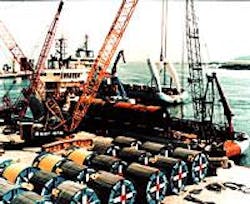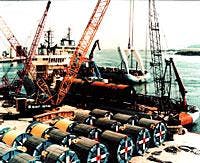Sara Sefton, Mike Acaster,Bridon Ropes
Tried and tested steel cable products offer solutions with proven experience and performance data for floating exploration and production facilities. However, the suspended weight of steel mooring comp- onents presents a challenge as increasing water depth raises the issue of the perceived limits for steel cables. But solutions for ultra deepwater are being developed that focus on increased strength, reduced weight, and improved endurance.
Advances in mooring system design have led to arrangements, using proven technology steel components, which are both technically and economically suitable for 1,950-m water depth. The potential for improvements in the strength-to-weight ratio suggests that the use of steel products in increasingly deeper locations can be achieved.
Solutions for ultra deep mooring are also being developed with non-metallic products. Current limitations of synthetic fiber ropes, however, require the connection to steel segments to be successful. Hence, a full understanding of the interactions of differing components is critical.
Technological advances
Increased strength or reduced cable weight has been achieved through the use of improved materials, manufacturing techniques, and engineering design. Considering the metallurgical properties required for rope making, and considering the expense and availability of exotic materials, the options are limited to developments in high-carbon steel.
The finished wire rope strength is governed by the properties of the component wires. In wire drawing, the quality of the finished product is only as good as the raw materials permit. Considering the metallurgical properties required for cable manufacture, the development of feed material has focused upon the increased sophistication of micro-alloyed, high-carbon steels.
The challenge lies in the manufacture of high-strength rod, which maintains suitable ductility for wire drawing and spinning into finished cable. The inclusion of lead patenting in the manufacturing process ensures a feed material of homogeneous structure from which the final strength can be generated.
The finished wire ultimate tensile strength is achieved through the combination of the number and sequence of drawing dies, the reduction in diameter achieved by each, and the efficiency of process control. Bridon converts the steel rod into wire on Frigerio multi-die wire drawing machines, using dry soap lubrication techniques and tungsten carbide dies for controlled geometry. Efficient air and water cooling systems provide significant improvements in wire quality, tensile strength, and ductility.
Continuing developments in stranded ropes for exploration moorings are leading to breaking loads over 30% higher than the standard API 9A values. Alternatively, if increased strength is not critical, the original requirement can be achieved with a smaller, and lighter, rope. Stranded ropes for long-term moorings require larger diameter wires with heavier zinc coatings.
Recent developments in wire technology are enabling development of large-diameter heavy galvanized wires with strength equal to drawn galvanized wires. This development in wire manufacture results in increased spiral strand breaking loads of 15% over Det Norske Veritas CN2.5, but more significantly, a 20% increase in the strength-to-weight ratio.
The introduction of Dyformed strands in these larger rope sizes has further improved the working properties of the rope. The compaction of the strand offers:
- Additional steel area, in turn offering increased breaking load
- A greater and smoother periphery, giving better contact area and reduced sheave wear
- Better resistance to abrasion and crushing, especially on drum coiling
- Improved stress distribution
- More effective diameter control.
Synthetic fiber
Synthetic fiber ropes offer the highest strength-to-weight ratio performance currently available and are being actively developed for ultra deepwater applications. However, as the fiber filaments are highly susceptible to damage through abrasion, there are usage limitations. The main areas of concern are the connection points both rig side and at the seabed.
A mooring line connected directly to an anchor will be embedded in the seabed and subject to considerable wear action, hence a robust solution is required for the lower 150 to 200 m. Historical practice has been to use chain, but steel cable solutions offer benefits in both superior fatigue performance and reduced drag resistance for anchor embedment.
At the upper end of the mooring line, similar constraints are apparent, as synthetic fiber ropes are extremely susceptible to damage when used with winches and sheaves. Furthermore, the potential for abrasive marine growth in the first 50-100 m of water makes the use of synthetic fibers questionable. Again, chain and, in some instances, stranded wire ropes have been used in this application.
Although various coatings, filters, and treatments are being investigated to protect the fiber, the products currently available are only suitable for use in the "central" taut segment away from the seabed, mechanical handling, and marine life.
Steel cables present solutions for these constraints. For the upper connection, the requirement for a flexible work-hardy product is satisfied by the use of Xtreme Dyform DB2K stranded ropes with rotary winch systems, whereas the lower segments are purely structural, so a spiral strand presents an ideal solution.
When connecting non-similar components in series, the effect of each on the other must be carefully considered. Experience suggests that the two critical factors in a combined taut moored system are torsion and fatigue performance.
Tension-torsion fatigue
Stranded rope will rotate when axially loaded. Synthetic fiber ropes have low torsional stiffness characteristics. Any rotation generated by the six-strand rope will not be resisted. The fiber rope is largely unaffected by the imposed rotation, effectively acting as a low-friction swivel.
Continued tension-torsion fatigue loads have been proven to dramatically reduce the life of stranded ropes, a situation that is exacerbated for a connection in series involving synthetic fiber ropes. In conventional catenary systems, stranded wire rope is prevented from rotating by the inherent torsional stiffness of the mooring chain, thereby maintaining the fatigue performance expected from tension-tension fatigue alone.
Stranded rope is considered unsuitable for long-term use in series with synthetic fiber ropes. In applications where replacement is possible, such as exploration rigs, stranded cables provide a suitable solution. Torsionally balanced constructions such as spiral strand, which does not generate rotation when loaded, are recommended for long-term applications.
Taut moored systems are subject to much greater tension-tension fatigue loadings than a conventional catenary system. Both synthetic fiber mooring ropes and spiral strand show excellent performance in tension-tension fatigue. Standard mooring chain exhibits a substantially lower performance in fatigue, and to achieve required performance criteria, the chain must be oversized. Where the suspended weight of the mooring line is critical, having to oversize heavy chain components is highly undesirable.
Future developments
Advances in system design have led to mooring arrangements using proven steel technology that offer technically and economically viable deepwater solutions. Bridon is working on future developments in water depths exceeding 2,000 m. Non-metallic solutions offer a way forward into ultra deepwater supported by improving steel solutions.
The high-strength rotation resistant cables such as Big Hydra are being developed for the increasing heavy lift demands, and Xtreme Bristar riser tensioner ropes with high density polymer impregnated cores to overcome the typical failure modes of internal stresses and bend fatigue. The range of Xtreme Dyform Bristar drilling lines continues to illustrate improvements in ton-mile service performance.
In 1983, Bridon supplied the first permanent mooring cable system for Exxon's Lena development in the Mississippi Canyon section of the Gulf of Mexico. Its more recent successes include the first set of Bridon Dyform DB2K anchor lines for Global Santa Fe's Rig Aleutian Key, operating off Equatorial New Guinea for Exxon-Mobil. It is also supplying eight 3.5-in. diameter, 10,500-ft Xtreme Dyform DB2K mooring lines for Global Santa Fe's newbuild Rig 184 and Rig 185 semisubmersibles, achieving minimum breaking loads of 720 tons as opposed to the API EEIPS 563 tons value for the same diameter. Recently, it also supplied the highest strength-to-weight ratio permanent mooring cable ever for the truss spars located at Kerr-McGee's Boomvang and Nansen fields in the Gulf of Mexico.




